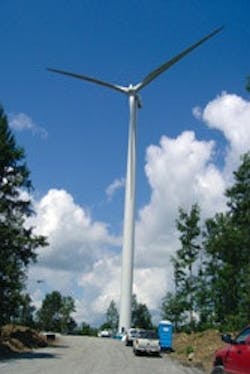Maple Ridge Wind Farm
Application:
Subgrade improvement for a wind farm access road.
The Challenge:
The Maple Ridge Wind Farm, projected to be the largest wind farm east of the Mississippi River, was on a tight schedule and had run into a major problem. Over 23 miles of access roads were needed in order to build 120 wind turbines in the project's first phase. CONTECH Construction Products, national distributor of Tensar Biaxial (BX) Geogrids, was contacted by the contracting firms D.H. Blattner & Sons and Delaney Construction in May 2005 to help assess soil conditions under the proposed access roads.
The original tower access road design included an undercut of approximately 10 in., inclusion of a geotextile and the installation of close to 10 in. of aggregate. The original width of the access roads was 16 ft. Several areas indicated the geotextile had ruptured or failed due to rutting. Soft to medium soils were found with an estimated CBR of approximately 0.8 to 1.6 based on the observed rutting depths of vehicle tracks.
The Solution:
The solution was simple. Tensar Earth Technologies' SpectraPave2 Software was used to determine the amount of aggregate that would be required for both the average and the worst-case CBR scenarios. The results indicated that by using BX1200 Geogrid, a minimum of 14 in. of Type 2 aggregate would be required for the access roads. This thickness would be increased to 22 in. where softer subgrades were encountered.
Using SpectraPave2 Software allowed the local CONTECH engineer to provide a set of formal designs within 24 hours of visiting the site. They ultimately became the solution to the contractor's urgent soft ground problems.
Since September 2005, approximately 453,000 sq yd of BX1200 have been installed at the Maple Ridge Wind Farm. The access road widths, in some areas, were widened from 16 to 32 ft to accommodate the 31-ft crane width. BX1200 was also installed beneath the crane platforms at each wind turbine location.
Tensar BX Geogrids were successfully used at the site to improve the bearing capacity of the soils, reduce the amount of aggregate required to stabilize the soils underlying the tower access roads and provide ease of construction. This allowed the high-profile project to stay on track and on time, while providing Lowville and its surrounding areas with a new source of power.
